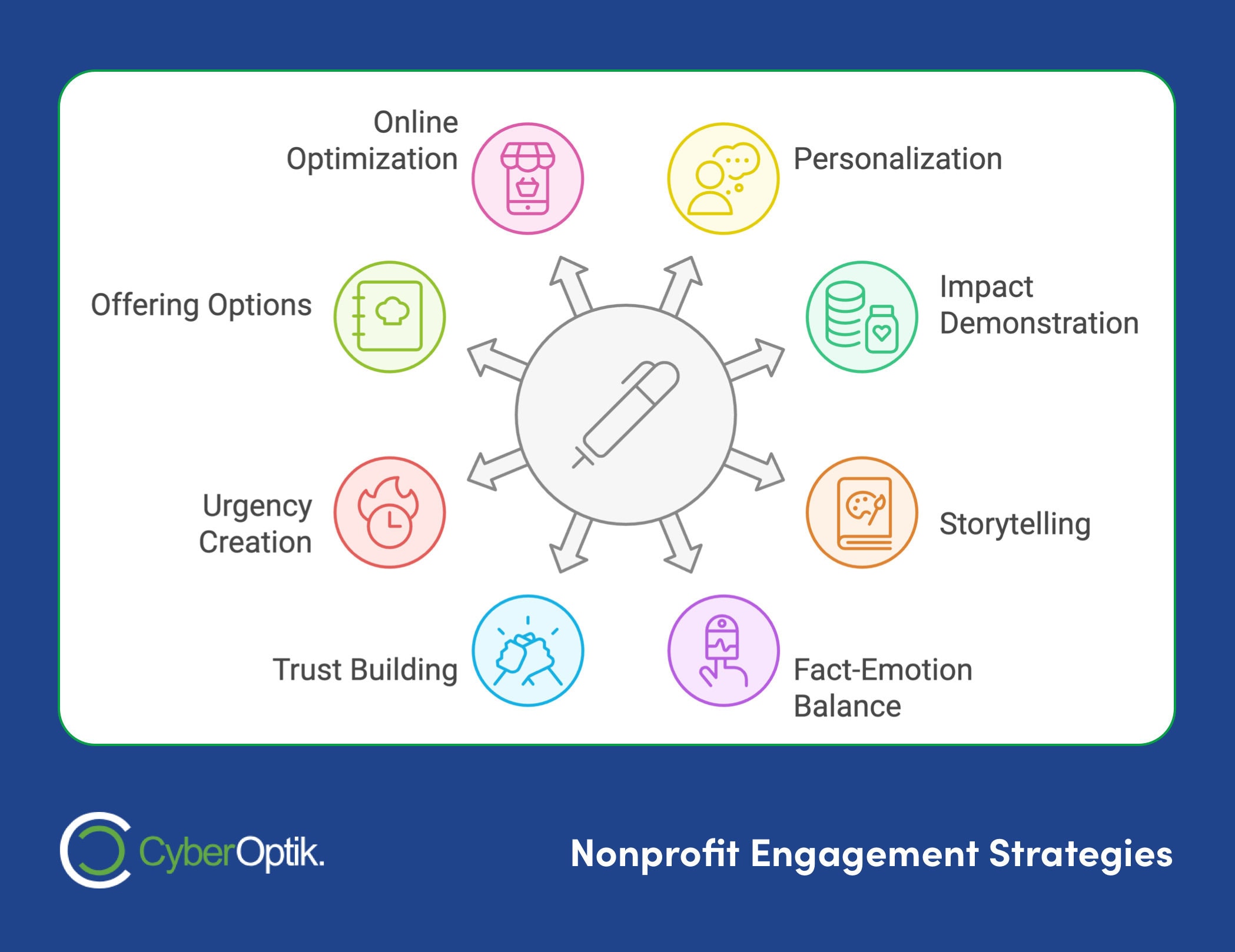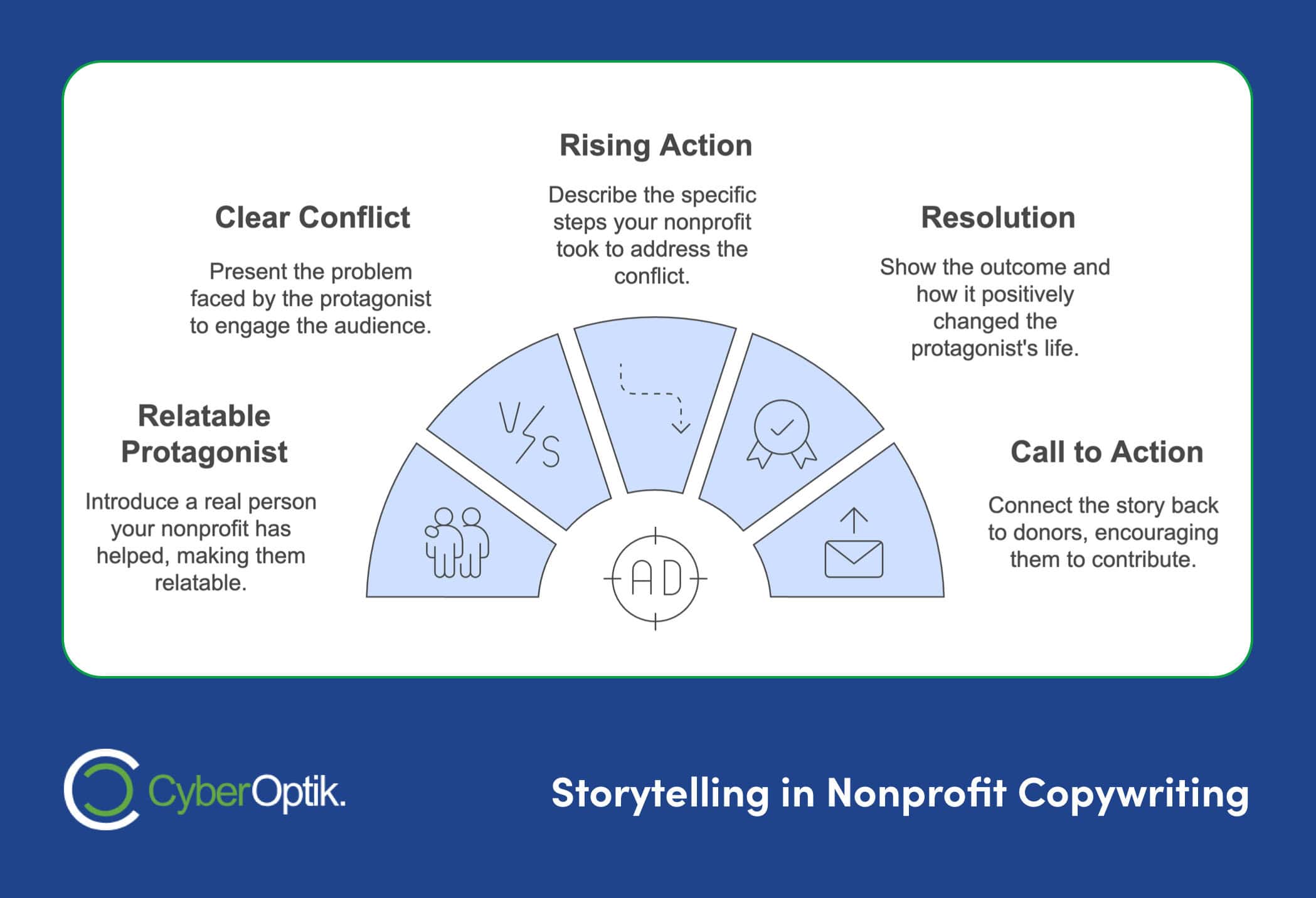Want to boost donations and engagement for your nonprofit? Here’s how to write copy that gets results:

- Make it personal – write like you’re talking to one person
- Show specific impact – explain exactly how donations are used
- Tell stories – share real examples of your organization making a difference
- Mix facts and emotions – use both data and compelling narratives
- Build trust – be transparent about where money goes
- Create urgency – give reasons to act now
- Offer options – provide different giving levels and ways to help
- Optimize for online – make website and email content scannable and mobile-friendly
- Test and measure – use A/B testing to see what resonates best
Key tips:
- Focus on the donor and how they can create change
- Be specific about impact (e.g. “$50 feeds a family for a week”)
- Use storytelling to make an emotional connection
- Include clear calls-to-action
- Keep language simple and conversational
Follow these strategies to craft nonprofit copy that inspires action and increases support for your cause.
Profiting with Nonprofits Ep.19 Copywriting | Turning Your Story Into Donors Ft Michal Eisikowitz
Getting Your Message Right
Nonprofit writing isn’t just about words. It’s about crafting messages that stick, inspire, and make people act. Let’s look at how to nail your nonprofit’s messaging and get more people involved.
Common Writing Problems
Lots of nonprofits mess up their messaging. They often:
- Don’t explain their impact clearly
- Talk about themselves instead of donors
- Use words that confuse readers
To avoid these mistakes, focus on your donors and keep things simple. Your supporters want to know how THEY can help.
Facts vs. Feelings
Good nonprofit writing needs both stories and stats. Here’s how to mix them:
- Start with a story that grabs attention
- Back it up with numbers showing your impact
- End by showing how donors can help
Instead of “We help the hungry”, try this:
“Thanks to people like you, we fed 50,000 families last year. But hunger doesn’t take breaks. Your donation today means Sarah, a single mom of three, won’t have to pick between rent and food for her kids.”
Building Trust
Trust is key for donors. Here’s how your writing can build it:
- Be clear about where money goes. Show what different amounts can do.
- Don’t just say you’re trustworthy. Prove it with examples of your work.
- Use quotes from people you’ve helped or other donors. It makes you more believable.
- Keep your message the same everywhere – on your website, in emails, and in letters.
Telling Your Story

Want to make your nonprofit’s copywriting pop? Use storytelling. It’s not about dumping facts. It’s about crafting narratives that stick with your audience and push them to act.
Parts of a Good Story
Here’s what you need for a story that grabs attention:
- A relatable protagonist
Introduce a real person your nonprofit has helped. Give them a name and paint their picture.
- A clear conflict
What problem did they face? This hooks your reader.
- Rising action
Show how your nonprofit jumped in. What specific steps did you take?
- Resolution
What was the outcome? How did it change their life?
- A call to action
Link the story back to your donors. Show them how they can create more success stories.
Ron Stefanski, an Online Entrepreneur and Marketing Professor, says:
“Your impact story can be an effective way to make an emotional connection between your organization’s audience and the work that you do.”
Success Stories
Real-life examples pack a punch. They bring your mission to life and show donors what their money does. Here’s how to craft them:
- Be specific: Don’t say “We help the homeless.” Tell John’s story – a 45-year-old vet who found housing and job training through your program.
- Use sensory details: Describe what people see, hear, and feel. It puts readers right in the story.
- Include direct quotes: Let your beneficiaries speak. Their words carry weight.
- Show the journey: Don’t just focus on the happy ending. Talk about the bumps along the way. It makes for a better story.
The Girl Effect organization nails this. They start with details about a 12-year-old girl, set up a problem, then show what’s possible. It helps donors see the impact of their support.
Numbers and Stories
Stories tug heartstrings. Data proves impact. Use both:
- Lead with the story
Grab attention with a personal tale.
- Follow up with data
Back up the story with stats that show your broader impact.
- Make numbers relatable
Don’t say “We provided 100,000 meals.” Say “We made sure 1,000 families didn’t go to bed hungry for three months.”
World Bicycle Relief does this well. They show a video about Georgina, a dairy farmer in Zambia. It shows how a bike changes lives. Then they back it up with stats on bikes given out and lives changed.
Good360 puts it well:
“Stories are more memorable and more convincing than just facts and figures. Our brains are hardwired to respond to stories.”
Writing Better Donation Requests
Want to boost contributions? Let’s dive into strategies that’ll make your donation requests pop.
Show Your Worth
When asking for money, you need to prove you’re worth it. Here’s how:
- Get specific: Don’t just say “We help people.” Instead, try “Your $50 feeds a family for a week.” See the difference?
- Use “because”: People love reasons. A Harvard study found that adding a “because” to your request can triple your success rate. So always explain why you need support.
- Make it personal: Use “YOU” in your appeals. It’s a simple trick that makes donors feel like they’re making a real impact.
Create Urgency
Want donors to act fast? Here’s how to light a fire under them:
- Highlight NOW needs: Use words like “INSTANTLY” to push for quick action. For example: “Your donation today INSTANTLY gives a family a place to sleep after the floods.”
- Set a countdown: Running a campaign? Make the end date clear. Try: “Only 7 days left to help us feed 1,000 homeless vets this winter.”
- Link to current events: Tie your ask to what’s happening now. Like: “As winter hits, your support can keep a child warm and fed.”
Offer Options
Give people choices, and they’re more likely to give. Here’s how:
- Show giving levels: Link different amounts to specific impacts:
- $25 – School supplies for one kid
- $50 – Feeds a family for a week
- $100 – A month of after-school programs
- Highlight small gifts: Use “SMALL” to make asks feel doable. Research shows this can double your donations.
- Push monthly giving: Sell the ease and impact of regular gifts. Try: “Just $10 a month keeps helping families all year long.”
- Include non-cash options: Some folks can’t give money but still want to help. Offer ways to donate stuff or time.
Remember what Sonia Simone of Copyblogger said:
“Your readers aren’t dumb; they’re distracted.” So keep it clear, punchy, and focused on how donors can make a real difference.
Writing for Online Success
Great online copywriting is key for nonprofits to boost engagement and donations. Let’s look at how to make your online content pop.
Better Website Writing
Your website is often the first place potential donors land. Here’s how to make it count:
Make it scannable. Use clear headlines and bullet points. You’ve got 5-8 seconds to grab attention when someone hits your site.
Tell your story. Engage both minds and hearts. As one expert puts it:
“If you want your audience to act, you must engage their minds and their hearts.”
Be clear and concise. Cut the fluff. If you can say it in 5 words instead of 7, do it.
Show your impact. Tell donors where their money goes. For example: “Your $50 feeds a family of four for a week.”
Use strong calls-to-action (CTAs). Make them clear and action-packed. Instead of “Click here”, try “Donate Now to Feed Families.”
Email Writing Tips
Email is still a powerhouse for nonprofits. Here’s how to make your emails pack a punch:
Think mobile-first. 49% of emails are opened on phones. Make sure yours look great on small screens.
Find your rhythm. Try sending newsletters every two or three weeks. One nonprofit found success with a weekly Monday newsletter and a featured resource email every other Wednesday.
Focus on one CTA. In fundraising emails, use one clear call-to-action to guide subscribers.
Make it personal. Use “YOU” in your appeals. It makes donors feel like they’re making a real difference.
Create urgency. Try phrases like: “Only 7 days left to help us feed 1,000 homeless vets this winter.”
But watch out for changing metrics. As Heather Mansfield, author and presenter, warns:
“Email open rates are no longer a reliable metric. Bots inflate opens and Apple now pre-loads email data regardless of whether a user opens an email.”
Social Media Posts
Social media is crucial for nonprofits. Here’s how to create posts that hit home:
Show your impact. Share success stories. For example: “Thanks to you, we fed 10,000 families last month.”
Spotlight supporters. Feature volunteers and donors. Include photos and stories of their contributions.
Go visual. Use images and videos. They’re more likely to be shared and remembered.
Ask questions. Use polls to get feedback and involve your audience.
Cross-promote. Share links to your blog or website to drive traffic.
Give a peek behind the curtain. Build trust by showing your team in action. Like: “Here’s our crew packing emergency kits for flood victims.”
Stay consistent. Create a social media plan to avoid random results. With 3.78 billion social media users in 2021 (up 5% from 2020), it’s a channel you can’t ignore.
Checking What Works
Let’s talk about how to know if your nonprofit copywriting is hitting the mark. It’s all about measuring results and tweaking your approach.
Success Measures
You need to keep an eye on these key numbers:
Conversion rate: This tells you how many people take action after reading your stuff. For donation pages, the average nonprofit sees a 17% conversion rate. If you’re below that, it’s time to shake things up.
Pageviews: Simple but crucial. If no one’s seeing your content, nothing else matters.
Average donation amount: This can make a big difference. The Irish Immigration Center saw their average donation jump by $100 just by redesigning their donation page.
Total revenue: The bottom line. It’s what all your efforts add up to.
These numbers aren’t just data points. They show you how well you’re connecting with your supporters.
Testing Your Writing
A/B testing is your secret weapon. Here’s how to do it:
- Pick one thing to test
Maybe it’s your email subject line or your “Donate” button color. Change just one thing at a time.
- Make two versions
Version A is what you’re using now. Version B is your new idea.
- Split your audience
Send each version to different groups.
- Check the results
Which one did better?
Here’s a real example: NextAfter tested two email types. One was a typical branded template. The other looked more like a personal email. The personal-looking one got 29% more donations.
They also found that emails from a real person (Kent Lassman) got 28% more opens than those from the organization name.
“Send your emails from a real person. People give to people, not to faceless organizations.” –
Making Updates
Use what you learn to keep improving:
- Set benchmarks: Look at your past results and industry averages. That’s your starting point.
- Use your data: If tests show personal emails work better, change your strategy.
- Keep testing: What works now might not work later. Regular testing keeps you on top of changes.
- Look at the big picture: Sometimes more clicks mean fewer donations. Always consider the overall impact.
Next Steps
You’ve got the nonprofit copywriting basics down. Now it’s time to put them to work. Here’s how to boost your engagement and donations:
Revamp Your Website Content
Give your website a good once-over. Make sure it clearly shows what you’re all about, what you do, and the difference you make. Pixel Lighthouse puts it well:
“Your content should express why you do what you do.”
Every page should scream your values and beliefs. That’s how you hook people emotionally.
Craft Compelling Stories
Build a stash of success stories that show your impact. Remember, people give to people, not faceless organizations. Spread these stories everywhere – your website, emails, social media. The works.
Optimize Your Donation Page
Take a page from the Irish Immigration Center’s book. They tweaked their donation page and boom – average donations jumped by $100. Focus on clear, punchy copy that shows donors exactly how their money helps.
Implement A/B Testing
Start small. Test one thing at a time. NextAfter found a neat trick: emails from a real person (Kent Lassman) got 28% more opens than those from the organization name. Why not try that with your next email blast?
Develop a Content Strategy
Make a plan that fits your goals. Look at the American Heart Association. They use SEO-optimized content to climb up the search rankings. Result? More donations and volunteers.
Create an Action Plan
Break down your copywriting goals into bite-sized tasks. Who’s doing what? When’s it due? Keep tabs on progress. This way, you’ll stay on track as you roll out these new strategies.
Now, get out there and start writing!




